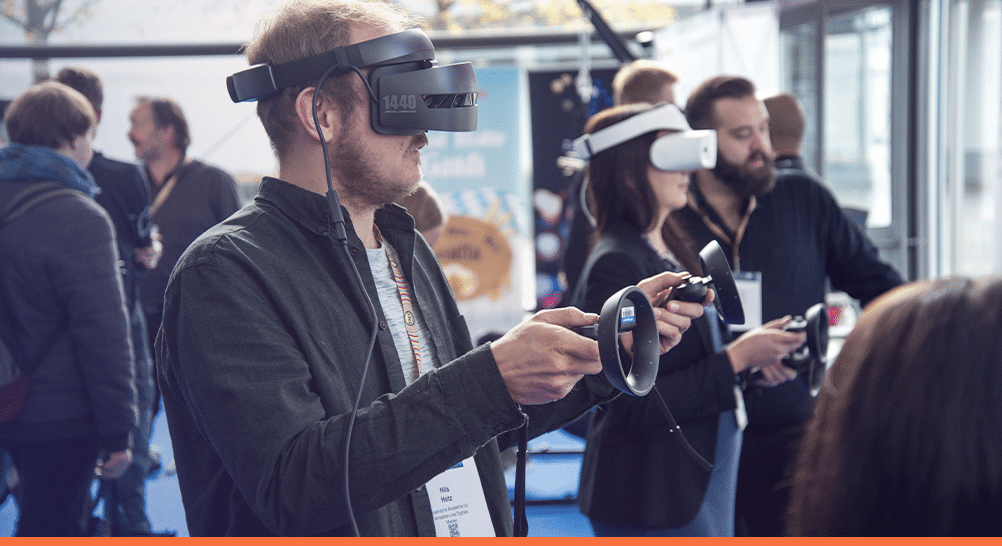Immersive shopping refers to a retail experience that incorporates technology and design elements to engage customers on a deeper level and create a more interactive and enjoyable shopping environment. It aims to go beyond the traditional brick-and-mortar or online shopping experience by using various immersive technologies and techniques to enhance the customer’s engagement, satisfaction, and overall shopping journey.
Virtual reality (VR) and augmented reality (AR)
Immersive shopping could utilize VR and AR technologies to provide customers with virtual or augmented experiences. For example, customers can try on clothes virtually using AR mirrors, explore 3D product models, or even walk through virtual stores from the comfort of their homes using VR headsets.
Interactive displays
Retailers could incorporate interactive displays and touchscreens into their stores, allowing customers to learn more about products, view additional options, or customize their purchases. These displays can provide detailed information and create a more engaging shopping experience.
Personalization
Immersive shopping could leverage customer data and artificial intelligence to offer personalized recommendations and suggestions. This tailors the shopping experience to each individual’s preferences, making it more relevant and enjoyable.
Gamification
Other immersive shopping experiences could incorporate elements of gamification to make the process more fun and engaging. Customers may earn rewards, play games, or participate in interactive challenges while shopping.
Mixed reality (MR)
Mixed reality combines elements of both physical and digital worlds to create a seamless experience. This might involve holographic displays or digital overlays on physical products, adding an extra layer of information and interactivity.
360-degree product views
Online retailers often provide 360-degree product views, allowing customers to see products from all angles. This immersive feature gives customers a better understanding of the product’s design and quality.
Virtual store tours
Virtual store tours enable customers to explore a retail space online, simulating the feeling of walking through a physical store. They can navigate through different sections, view products, and make purchases as if they were in the store.
Enhanced sensory experiences
Immersive shopping could engage multiple senses, such as touch, smell, and sound, to create a more immersive environment. This might involve fragrance diffusers, haptic feedback devices, or background music that complements the shopping theme.
Online and offline integration
Retailers often integrate online and offline shopping experiences to provide a seamless journey for customers. For instance, customers can order products online and pick them up in-store, or they can return online purchases to a physical location.
Successful immersive shopping examples
Many retailers are already experimenting with ways to integrate tech to enhance CX:
- The North Face
The North Face implemented VR experiences in some of its retail locations, allowing customers to virtually explore outdoor environments and test their products. - Mercedes-Benz
Car dealerships, including Mercedes-Benz, have used VR to provide virtual test drives and tours of vehicles. - H&M
H&M experimented with an AR app that allowed customers to see digital fashion models wearing the latest clothing collections when they pointed their smartphone cameras at in-store signs. - Adidas
Adidas created an AR experience that allowed customers to virtually try on shoes and see product information in real time. - Nike
Nike has used augmented reality to create interactive in-store experiences, such as allowing customers to see product information and design details when they scan products with their mobile devices. - IKEA
IKEA has used augmented reality (AR) apps that allow customers to visualize how furniture and home decor items will look in their own homes before making a purchase. - Sephora
The beauty retailer uses AR technology to enable customers to virtually try on makeup products through their app. - Lowe’s
Lowe’s introduced an app that uses AR to help customers visualize how home improvement products will look in their homes. - Walmart
Walmart has been exploring virtual reality (VR) applications, such as VR training for its employees, to enhance both the customer and employee experience. - Amazon
Amazon has experimented with AR shopping experiences, like “AR View” for furniture visualization and the Amazon app’s “Part Finder” feature for identifying and ordering replacement parts.
The goal of immersive shopping is to create a memorable and enjoyable shopping experience that encourages customers to spend more time in-store or online, make informed purchasing decisions, and build a stronger connection with the brand. It can help retailers differentiate themselves in a competitive market and cater to the evolving expectations of modern consumers.
If you are wanting to integrate immersive technology but are concerned about your ROI, MarketDial would love to help you test out your ideas. Also, check out these resources:
Preparing to catch the retail Generative AI wave
Voice commerce: Revolutionizing shopping through the power of speech
Retail biometrics: Exploring new possibilities
Tailoring the retail experience with hyperpersonalization




